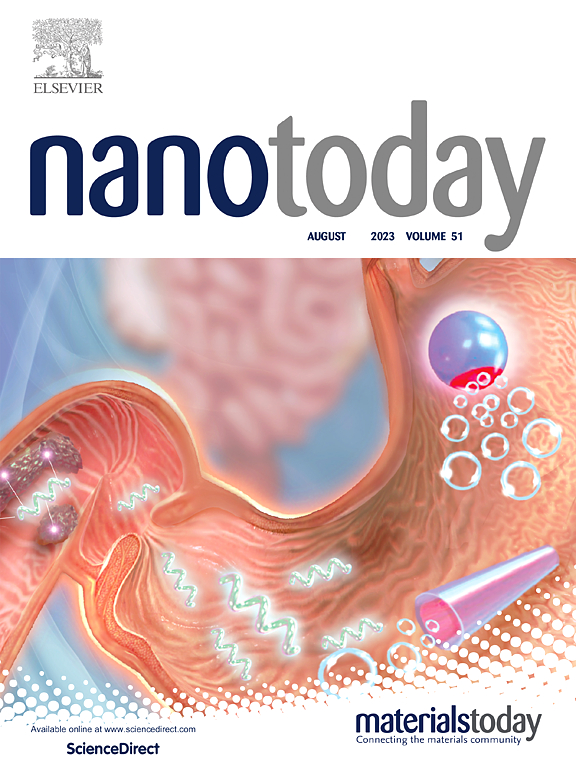多波段高温电磁波响应双金属耦合多孔碳化硅
IF 10.9
1区 材料科学
Q1 CHEMISTRY, MULTIDISCIPLINARY
引用次数: 0
摘要
由于材料固有的介电或磁性能,开发具有多波段响应的电磁波吸收材料对新型电子器件和雷达隐身是一个艰巨的挑战。特别是传统的多波段响应磁复合材料,由于高温下的磁衰减,成为研究的瓶颈。本文利用有序介孔硅模板衍生的介电SiC与磁性金属化合物结合,实现了传统SiC-金属复合吸波剂无法实现的多波段响应特性和高温吸收性能。所构建的双金属掺杂SiC复合材料继承了丰富的组分(SiC、FeSi和CoSi)、独特的结构和众多的缺陷(空位和层错),促进了CoSi/SiC和FeSi/CoSi/SiC复合材料的多波段响应行为,覆盖了C、X和Ku波段。在匹配厚度仅为1.63 mm时,FeSi/CoSi/SiC复合材料的反射损耗(RL)值为−53.13 dB。此外,FeSi/CoSi/SiC复合材料经550℃高温氧化后仍保持了优异的EMW吸收性能。实验结果和理论分析表明,复合材料的多层次结构、丰富的缺陷和异质界面以及磁性元素有助于其阻抗匹配、介电损耗和磁损耗能力,从而提高了多波段响应特性。因此,这项工作为构建多波段响应材料提供了一种策略,这可以为介电学,光学响应和柔性电子学等其他领域提供倡议。本文章由计算机程序翻译,如有差异,请以英文原文为准。
Bimetallic coupled porous SiC for multi-band and high-temperature electromagnetic wave response
Developing electromagnetic wave (EMW) absorption materials with multi-band response is a daunting challenge for new electronic devices and radar stealth due to the intrinsic dielectric or magnetic properties of the material. Particularly, traditional multi-band responsive magnetic composite has become a research bottleneck due to magnetic decay at high temperatures. Herein, we use dielectric SiC derived from the ordered mesoporous silicon template to combine with magnetic metal compounds to achieve multi-band response characteristics and high-temperature absorption performance that traditional SiC-metal composite absorbers cannot achieve. The constructed bimetal-doped SiC composite inherits abundant components (SiC, FeSi, and CoSi), unique structures, and numerous defects (vacancies and stacking faults), which promote the multi-band response behavior of CoSi/SiC and FeSi/CoSi/SiC composites, covering the C, X, and Ku bands. The FeSi/CoSi/SiC composites achieve a reflection loss (RL) value of − 53.13 dB at a matching thickness of only 1.63 mm. Furthermore, FeSi/CoSi/SiC composite still maintains outstanding EMW absorption performance after high-temperature oxidation (550 ℃). Experimental results and theoretical analysis show that the multi-level structure, abundant defects and heterointerfaces, and magnetic elements in the composite contribute to its impedance matching, dielectric loss, and magnetic loss capabilities, thus promoting multi-band response characteristics. Therefore, this work provides a strategy for constructing multi-band responsive materials, which can provide initiatives for other fields such as dielectrics, optical responses, and flexible electronics.
求助全文
通过发布文献求助,成功后即可免费获取论文全文。
去求助
来源期刊

Nano Today
工程技术-材料科学:综合
CiteScore
21.50
自引率
3.40%
发文量
305
审稿时长
40 days
期刊介绍:
Nano Today is a journal dedicated to publishing influential and innovative work in the field of nanoscience and technology. It covers a wide range of subject areas including biomaterials, materials chemistry, materials science, chemistry, bioengineering, biochemistry, genetics and molecular biology, engineering, and nanotechnology. The journal considers articles that inform readers about the latest research, breakthroughs, and topical issues in these fields. It provides comprehensive coverage through a mixture of peer-reviewed articles, research news, and information on key developments. Nano Today is abstracted and indexed in Science Citation Index, Ei Compendex, Embase, Scopus, and INSPEC.
 求助内容:
求助内容: 应助结果提醒方式:
应助结果提醒方式:


